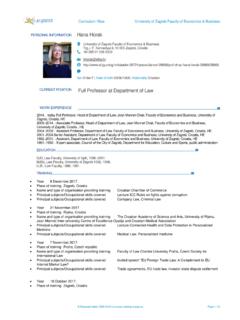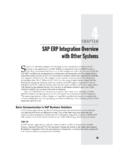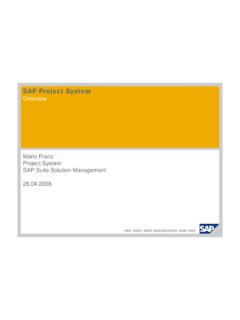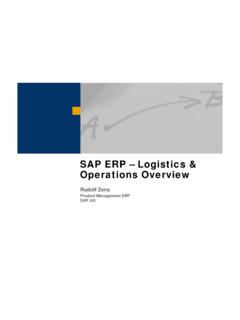Transcription of ERP System Implementation and Business Process Change ...
1 Journal of Computing and Information Technology 1 ERP System Implementation and Business Process Change : Case Study of a Pharmaceutical Company Vesna Bosilj-Vuksic and Mario Spremic Department of Business Computing, Graduate School of Economics & Business , University of Zagreb, Croatia The main objective of this paper is to present the impacts of information technology (IT) and enterprise resource planning (ERP) systems in Business Process renovation and to discuss selected aspects of the Business processes and information modelling. This study presents the results of research conducted on reengineering Business processes in Croatian companies, together with the results of analysis of the status and characteristics of ERP systems in Croatian companies.
2 The results of this study were used to form hypotheses, which were then analyzed and compared against the results of a case study conducted by the authors on Business Process reengineering and the Implementation of the SAP software solution in PLIVA pharmaceutical industry, Incorporated (PLIVA pharmaceuticals, Inc). Keywords: Business Process Change , enterprise resource planning (ERP), Business Process modelling, SAP, PLIVA pharmaceuticals Inc. 1. Introduction In order to survive in highly competitive Business environments, companies have to continuously Change their Business processes. New conditions in the marketplace have provided a special stimulus to modelling Business processes over the past ten years: product expansion, competitive sales conditions, development of global distribution networks, better informed customers, and the orientation of businesses towards satisfying the individual needs of the customer.
3 In the light of this, Business Process reengineering has often been employed, and information technology is a frequently utilized approach used to improve Business processes. This paper stresses the necessity for organizational restructuring in the context of global information connectivity. Business Process Reengineering (BPR) is an organizational method demanding radical redesign of Business processes in order to achieve greater efficiency, better quality and more competitive production (Hammer and Champy, 1993). It means analyzing and altering the Business processes of the organization as a whole. A Business Process includes activities and tasks that cross functional and/or organizational boundaries.
4 Information technology (IT) is the most important factor in enabling newly redesigned processes. Modern information technology is oriented towards Business processes and communications between persons using these processes, and is therefore called Process and information technology (Ould, 1995). In that way, BPR can be described as organizational Process redesign, with the direct influence of IT. Despite the fact that many academics and practitioners agree with this idea, BPR and information systems modelling are still performed separately. The objective of this paper is to examine this domain and to propose a framework for Business Process modelling and IT integration .
5 The primary objective of this paper was to explore the relationship between IT, ERP and Business Process Change . The evaluation of BPR is described in Section 2. A brief overview of ERP systems and the results of ERP systems analysis conducted in Croatia are presented (Section 3). The framework for Business Process renovation and ERP systems modelling is provided in Section 4, as are the results of research on BPR conducted in Croatian companies. A case study of ERP System solutions implemented in the pharmaceutical company PLIVA is described in Section 5. Finally, the conclusions outlining the main findings of this research are presented in Section 6.
6 ERP System Implementation and Business Process Change : Case Study of a Pharmaceutical Company 2 2. Reengineering Business : History and Evolution BPR has become one of the most popular topics in organizational management, creating new ways of doing Business (Tumay, 1995). Many leading organizations have conducted BPR in order to improve productivity and to gain a competitive advantage. However, regardless of the number of companies involved in reengineering, the success rate of reengineering projects is less than 50% (Hammer and Champy, 1993). Some frequently mentioned problems related to BPR include the inability to accurately predict the outcome of radical Change , difficulty in capturing existing processes in a structured way, lack of creativity in Process redesign, the level of costs incurred in implementing the new Process , and the inability to recognize the dynamic nature of the processes.
7 On the other hand, CPI (Continuous Process Improvement) integrates methods such as industrial engineering, systems analysis and design, socio-technical design and total quality management (Davenport, 1993; Galliers, 1998). Continuous improvement refers to programs and initiatives that emphasize incremental improvements in work processes and outputs over an open-ended period of time (Davenport and Beers, 1995). Several researchers suggest that the use of CPI techniques dramatically increases competitive advantage. Furthermore, it is particularly suggested that TQM (Total Quality Management) should be integrated with BPR (Al-Mashari and Zairi, 1999).
8 Business Renovation (BR) integrates the radical strategic method of BPR and more progressive methods of Continuous Process Improvement (CPI) with adequate IT (Kovacic et al., 2001). Process renovation is a reengineering strategy that critically examines current Business practices and procedures, re-thinks them through and then redesigns the mission-critical products, processes and services (Prassad, 1999). The analysis of published BPR cases suggests that Hammer s well-known definition of BPR is too limited, as it focuses on processes and ignores other important aspects of institutions such as organizational structure, people, communication and IT (Grant, 2002).
9 In the 1990s, BPR focused on internal benefits such as cost reduction, company downsizing and operational efficiency, which are more tactically than strategically focused. Nowadays, e- Business renovation strategies focus on the processes between Business partners and the applications supporting these processes. These strategies are designed to address different types of processes with the emphasis on different aspects (Phipps, 2000; Kalakota and Robinson, 2001): customer relationship management, supply chain management, selling-chain management, and enterprise resource planning. By strictly pursuing a Process perspective, businesses are restructured across functional and hierarchical boundaries.
10 To accommodate these changes, organizations may need to be restructured around these new Business processes (Grover and Malortha, 1997). BPR driven by e- Business should not be based solely on the radical redesign of intra-organizational processes, but should be extended to the entire Business network (internal and external). An enhancement geared to include inter-organizational processes is called Business Network Redesign (Alt et al., 2000). Business Network Redesign (BNR) is driven by global information connectivity and e-commerce. It identifies inter-organizational processes to redesign and extend the strengths of BPR to networking among Business partners.












